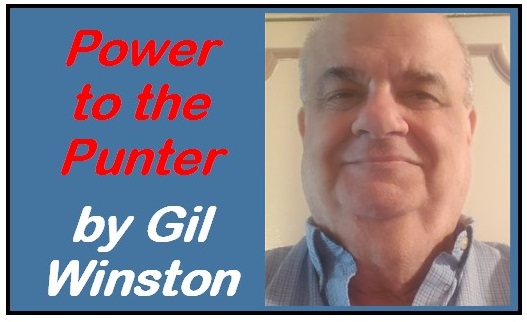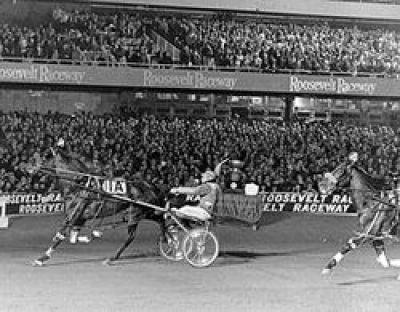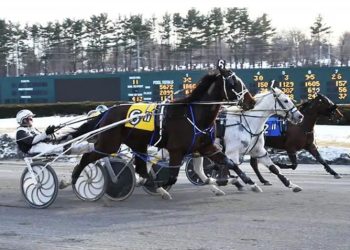There were only a few sure things about harness racing in the 1960s. Harness racing owned the night in the New York City metropolitan area, and nobody could make a living betting on them. Neither of those sure things held. How did it all begin?
 Children knew all about harness racing before ever making a bet because it was on television. Well known drivers did TV commercials. Races and stories frequented the back pages of the local tabloids adjacent to the baseball stories. The NFL and NBA had not yet surpassed harness racing in popularity. More than 20,000 patrons attended Yonkers or Roosevelt, every night, six nights a week.
Children knew all about harness racing before ever making a bet because it was on television. Well known drivers did TV commercials. Races and stories frequented the back pages of the local tabloids adjacent to the baseball stories. The NFL and NBA had not yet surpassed harness racing in popularity. More than 20,000 patrons attended Yonkers or Roosevelt, every night, six nights a week.
I graduated from high school at the age of sixteen (skipped a year) and immediately got a rack clerk job on Wall Street. That job title no longer exists in the banking world. My job was being an aid to the tellers.
The parents of a friend of mine were both huge harness racing fans. His mother went to Roosevelt or Yonkers (whichever was open) every Wednesday with her friends and his father went every Friday. No cars were needed. The bus with the big TROTTERS sign pulled up to their Brooklyn apartment house every night and dropped them home after the races.
My friend told me that any time I wanted to make a bet on Wednesday or Friday, I should let him know. I doubted that would happen. One morning after coming up from the subway on Wall Street, I saw these forms hanging from a huge metallic clip on the newsstand on the corner of Wall and William Streets. The heading was Doc Robbins’ Tomorrow’s Trots. My new life had started.
I took the form into the stock room and pored over the races. I cannot state with certainty what led me to select Nibble Killean with a driver named William Gilmour and Gone Goslin with a driver named Del Insko, but I called my friend and wagered two dollars to win on each. Nibble Killean won at 5-1 while Gone Goslin won at 8-5 and we were off to the races, so to speak.
A fellow rack clerk, Ken Marcel, was a little older and already a big racing fan. We started heading out to the track every other Friday (payday) after work. This required multiple subway changes and a bus ride to arrive before the daily double.

I still remember how we were greeted at Yonkers by the Daily Double song. “I went down to the track today with just two bucks from last week’s pay. I picked two longshots on the way to play the daily double. I never thought that they would win, but in the stretch they both flew in. That’s the way the fun begins. I won the daily double.” There were other words, but it ended with, “Play day can be payday when you win the daily double.”
Soon we were going more frequently than every other Friday, and I found I would win regularly. My next job was at New York Life, and I found out that there was a bookmaker on the premises. After my first $5 win bet with him produced a 40-1 winner, he refused to take any more bets from me.
I was now making a living as a computer programmer (I was able to get the new job because I was going to Brooklyn College at night) and friends suggested I write a program on winning at the track. Sounded great, so I went to work. As I was defining the rules for the program, I realized that so much that I did was not quantifiable. If I was somehow able to assign values, the data input requirements would be monstrous and would not be workable. That plan ended.
A recession hit hard a few years later and I decided to take a chance at betting the harness races for a living. It turned out to be a stellar decision. I learned that it was easier to make money at the smaller venues, so I summered in the Catskill Mountains and wintered at Pompano Beach.
The grandstands of Monticello Raceway and Pompano Park were my business offices. With my winnings I bought horses and earned myself a trainer’s license. I also got a driver’s license, but with my lack of depth perception (a medical condition known as single vision), becoming a driver seemed like a really, really bad idea.
Making enough money on a regular basis to make a living is a lot more difficult, today, than it was back-in-the-day for many reasons. But being successful at the windows (or should I say ‘on your smartphone’) is still doable. In future articles we will go into the changes that makes it more difficult (maybe some of you can learn and develop ways to counteract the difficulty), but more importantly, the correct way to approach races and how to increase your probability of winning. You will win more often than you had in the past. As far as I am concerned, harness racing is still the single most winnable wagering game in our gambling-crazed nation.
Let’s end this article with this opinion. If you wish to treat wagering on the races as pure entertainment, please continue to do so. Somebody somewhere is hitting a superfecta or a pick-4 because they played their grandmother’s telephone number. Maybe it will be you.
However, if you want to take wagering seriously and have the need to invest “only” $2 on a bet based on a hunch because it would hurt too much if your “number” came in and didn’t play it, you are doomed. I have never made such a bet and never will. I can be happy for a friend whose horse wins a race, but I only bet on the horse if I think it can win. My remorse if the horse wins and I bet against him is identical to losing a bet on any horse. Gambling is not a popularity contest. Never forget that.
Power to the punter.
by Gil Winston, for Harnesslink

 USA
USA Canada
Canada Australia
Australia New Zealand
New Zealand Europe
Europe UK / IRE
UK / IRE



